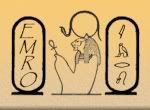Artist Unknown
Early 3rd Century CE
Marble 14 1/2 "
The Metropolitan Museum of Art, NY
 Click on picture to enlarge.
Click on picture to enlarge.His name was Marcus Aurelius Antoninus (r. 211-17 AD). His nickname was Caracalla (after the type of cloak he wore and made popular). The nickname was originally used derisively and never officially. He was a military emperor of Rome who killed his own brother Geta to rule Rome. Caracalla had his brother's memory wiped out (damnatio memoriae).
He was assassinated in Edessa on April 8, 217 AD.
There's Caracalla's back story. The portrait above is an Art Classic. Romans strove toward realism (verism) in portraits--warts and all, and were particularly adept at capturing personality and character. That is what makes the above bust a striking portrait.
There are many portraits of Caracalla in busts, paintings, and coins. Comparing a few will reveal just what a striking and probably extremely accurate portrait this is.
First, there is the portrait of him on the Severan Tondo (with his brother deliberately wiped out on the bottom left):

Here he is a child but it is a portrait of a "knowing child." He wears a crown and a determined and ambitious gaze compared to the tender gazes of his parents. Pay particular attention to his gaze and brow line.
Here is a bust of Caracalla from Egypt:

This one is obviously more of a conceptual image or caricature and not veristic, but the attitude is there. His frown is exaggerated, but once again, one must look at this subject's gaze and brow ridge. This is an ambitious man who means business. He isn't idealized as Augustus preferred himself to be portrayed to convey a sense of immortality.
Below is a coin struck with his image in profile. Though the source of his nickname is disputed, one can see the type of cloak he wore in this image. He still possesses the strength and focus of a man with a disciplined military background.
Let's return to the subject of this Art Classic -- the bust from the third century now in the Metropolitan Museum of Art. Aside from the extreme verism of the portrait, what is compelling about this image is the personality of the sitter. This is a serious and determined man. He is rugged and stern. His hair is imbued with tension as the tight curls are close-cropped to his head and worn almost as a helmut. His chin is strong and the turn of his neck convinces us that he's turned to look at us, though we know he's just a marble bust--and we are intimidated. There is an extreme tension and strong potential energy to this piece. What is most compelling is his gaze.

His brow is furrowed and his eyes focused and intense. The artist took great care in shaping his eyes, carving the irises and pupils, as well as directing his gaze. It almost looks as if the subject sat for the sculptor. While the other images in this entry capture aspects of Caracalla and show his development in representational or conceptual ways, this bust is a real presence that imposes itself on us.
Source
(1) http://www.roman-emperors.org/caracala.htm
The year 212 saw a flurry of administrative reforms under the young emperor's leadership. Soldiers received increases in pay and in legal rights, but the most noteworthy change was the bestowal of Roman citizenship upon all free residents of the empire. This grant of universal citizenship, called by scholars the Constitutio Antoniniana, allowed for greater standardization in the increasingly bureaucratic Roman state. Construction was also well underway on the magnificant baths in Rome that would bear the emperor's name. The main building seems to have been completed four years later, but the entire complex was not finished until the reign of Alexander Severus.
Caracalla spent little time in Rome after the spring of 213. A visit to Gaul and a military campaign along the borders of Upper Germany and Raetia occupied much of the rest of the year. Winter may have been spent in Rome, but the following year Caracalla made a journey to the East in preparation for a war against the Parthians. Along the way, the emperor displayed an increasing fascination and identification with Alexander the Great. Like the Macedonian prince, however, Caracalla would not survive an expedition to the East.(1)
He was assassinated in Edessa on April 8, 217 AD.
There's Caracalla's back story. The portrait above is an Art Classic. Romans strove toward realism (verism) in portraits--warts and all, and were particularly adept at capturing personality and character. That is what makes the above bust a striking portrait.
There are many portraits of Caracalla in busts, paintings, and coins. Comparing a few will reveal just what a striking and probably extremely accurate portrait this is.
First, there is the portrait of him on the Severan Tondo (with his brother deliberately wiped out on the bottom left):

Here he is a child but it is a portrait of a "knowing child." He wears a crown and a determined and ambitious gaze compared to the tender gazes of his parents. Pay particular attention to his gaze and brow line.
Here is a bust of Caracalla from Egypt:

This one is obviously more of a conceptual image or caricature and not veristic, but the attitude is there. His frown is exaggerated, but once again, one must look at this subject's gaze and brow ridge. This is an ambitious man who means business. He isn't idealized as Augustus preferred himself to be portrayed to convey a sense of immortality.
Below is a coin struck with his image in profile. Though the source of his nickname is disputed, one can see the type of cloak he wore in this image. He still possesses the strength and focus of a man with a disciplined military background.
Let's return to the subject of this Art Classic -- the bust from the third century now in the Metropolitan Museum of Art. Aside from the extreme verism of the portrait, what is compelling about this image is the personality of the sitter. This is a serious and determined man. He is rugged and stern. His hair is imbued with tension as the tight curls are close-cropped to his head and worn almost as a helmut. His chin is strong and the turn of his neck convinces us that he's turned to look at us, though we know he's just a marble bust--and we are intimidated. There is an extreme tension and strong potential energy to this piece. What is most compelling is his gaze.

His brow is furrowed and his eyes focused and intense. The artist took great care in shaping his eyes, carving the irises and pupils, as well as directing his gaze. It almost looks as if the subject sat for the sculptor. While the other images in this entry capture aspects of Caracalla and show his development in representational or conceptual ways, this bust is a real presence that imposes itself on us.
Source
(1) http://www.roman-emperors.org/caracala.htm
© Stephanie Lewis, 2007






No comments:
Post a Comment